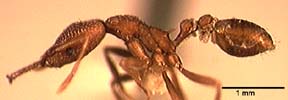Strumigenys fairchildi Brown 1961
Dacetini, Myrmicinae, Formicidae, Hymenoptera, Insecta, Arthropoda, Animalia
John T. Longino, The Evergreen State College, Olympia WA 98505
USA.
longinoj@evergreen.edu
21 April 1997

Specimen: Costa Rica, Prov. Heredia: La Selva Biological Station (J. Longino 1425). INBIOCRI001284019. Image by J. Longino.
Identification
Apical fork of mandible with two intercalary teeth; mandible with two pronounced preapical teeth; eye large, with over 35 facets; dorsal and ventral teeth of propodeal lamella pronounced, acute; gaster finely longitudinally striolate, opaque-sericeous throughout.
Head length 0.96mm, mandible length 0.59, CI 75, MI 61 (n=1 holotype worker from Panama; Brown 1961).
Similar species: tococae
Range
Panama, Costa Rica (lowlands of both slopes).
|

Specimen: Costa Rica, Prov. Heredia: La Selva Biological Station (J. Longino 1425). INBIOCRI001284019. Image by J. Longino. |
Natural History
Brown and Wilson (1959) summarize the genus as follows:
"Widespread in tropics and warm temperate areas. Primarily forest-dwelling; some species occur in grassland and arid scrub. ... Nests mostly in soil and rotting wood; a few species live in arboreal plant cavities in tropical rain forest. Foraging hypogaeic to epigaeic-arboreal. Food: most species are collembolan feeders; a few are polyphagous predators or occasionally feed on sugary substances..."
fairchildi is arboreal, and nests in dead wood.
Selected Records
La Selva: canopy fogging sample.
La Selva: worker on Inga extrafloral nectary.
Carara: dense second growth vegetation at edge of tall wet forest. Lone queen in dead stick of treefall.
Literature Cited
Brown, W. L., Jr. 1961. The Neotropical species of the ant genus Strumigenys Fr. Smith: Miscellaneous concluding studies. Psyche 68:58-69.
Brown, W. L., Jr., Wilson, E. O. 1959. The evolution of the dacetine ants. Quarterly Review of Biology 34:278-294.
 Go back to top
Go back to top

